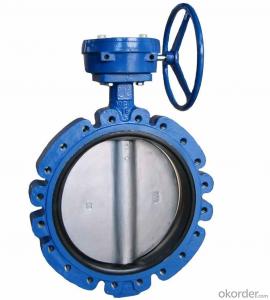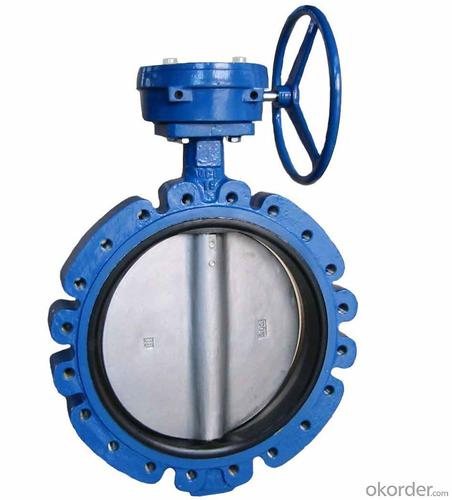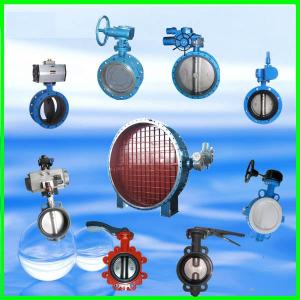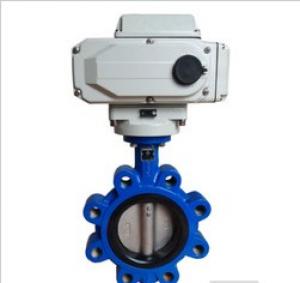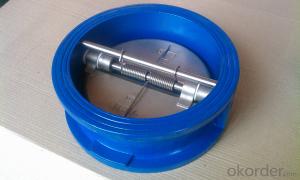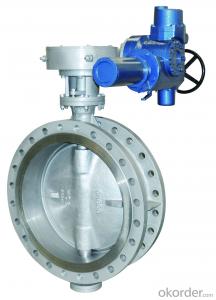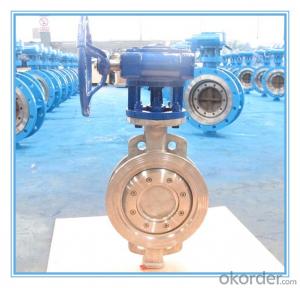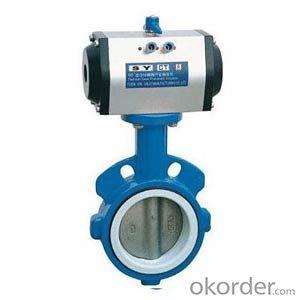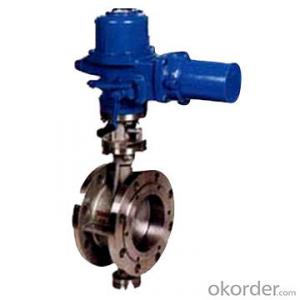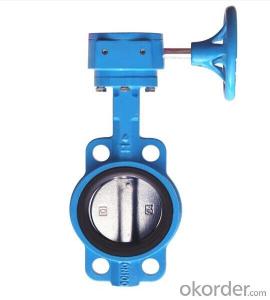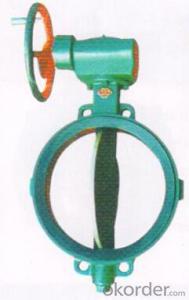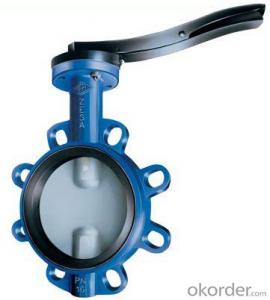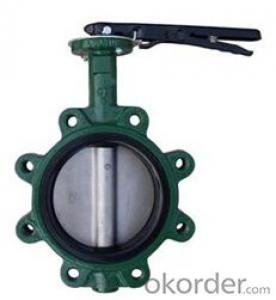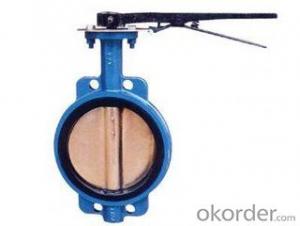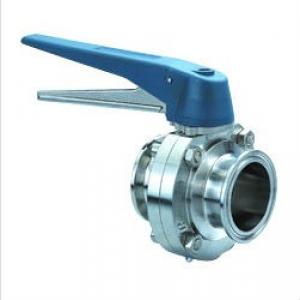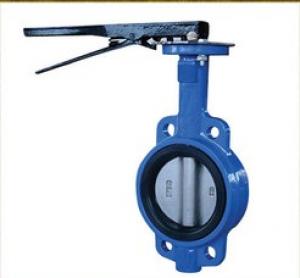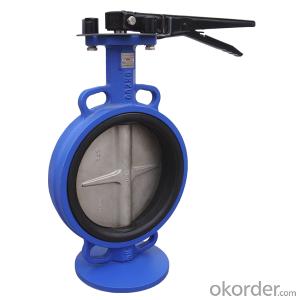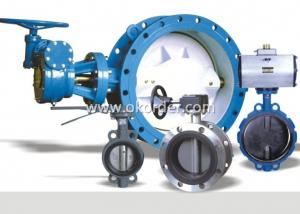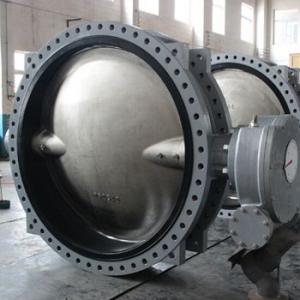Butterfly Valve Turbine Type DN150 BS Standard
- Loading Port:
- Tianjin
- Payment Terms:
- TT OR LC
- Min Order Qty:
- 50 pc
- Supply Capability:
- 5000 pc/month
OKorder Service Pledge
OKorder Financial Service
You Might Also Like
1. Manual Wafer Butterfly Valve Description:
A butterfly valve is a valve which can be used for isolating or regulating flow. The closing mechanism takes the form of a disk. Operation is similar to that of a ball valve, which allows for quick shut off. Butterfly valves are generally favored because they are lower in cost to other valve designs as well as being lighter in weight, meaning less support is required. The disc is positioned in the center of the pipe, passing through the disc is a rod connected to an actuator on the outside of the valve. Rotating the actuator turns the disc either parallel or perpendicular to the flow. Unlike a ball valve, the disc is always present within the flow, therefore a pressure drop is always induced in the flow, regardless of valve position.
2.Main Features of the Manual Wafer Butterfly Valve
a)Cast hole. Flange connection meet ANSI 125/150# DIN PN10/16 BS4504 PN10/16 in the meanwhile.
b)Soft seat. Replaceable. Increase of service life.
c)Double half shaft without pin.
d) Square and short neck. Easy to stick scutcheon and cost saving.
3. Manual Wafer Butterfly Valve Images:
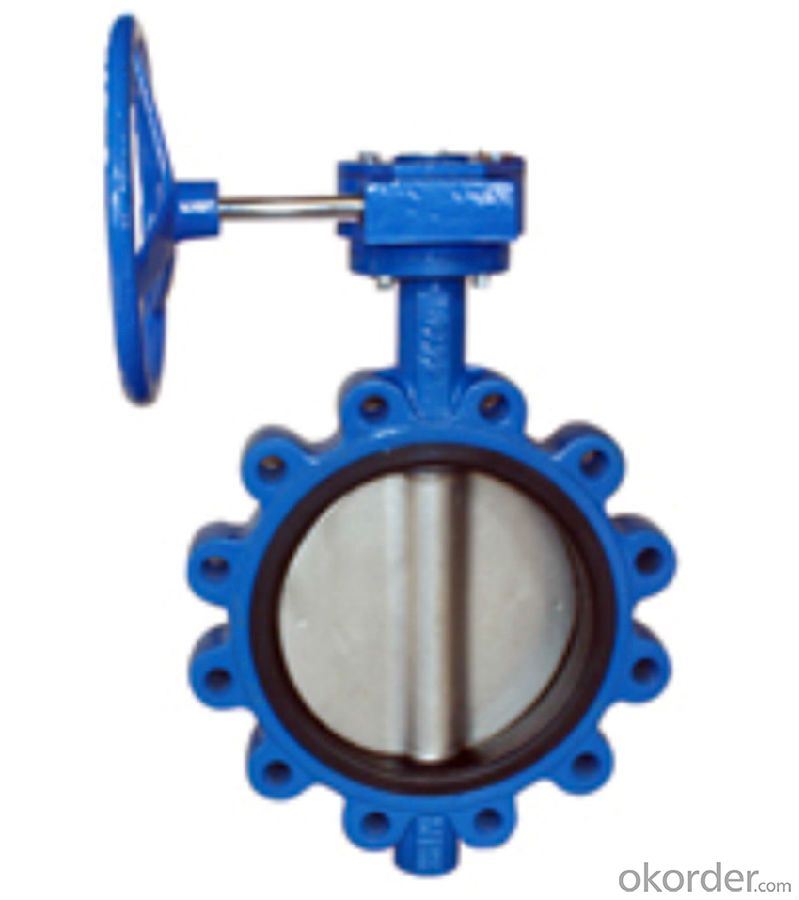
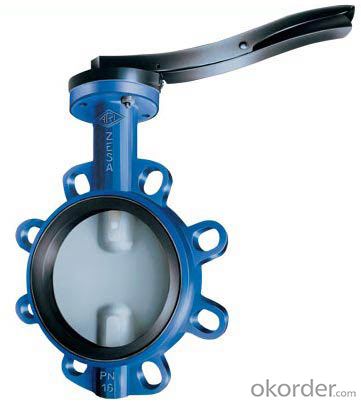
4.Manual Wafer Butterfly Valve Specification:
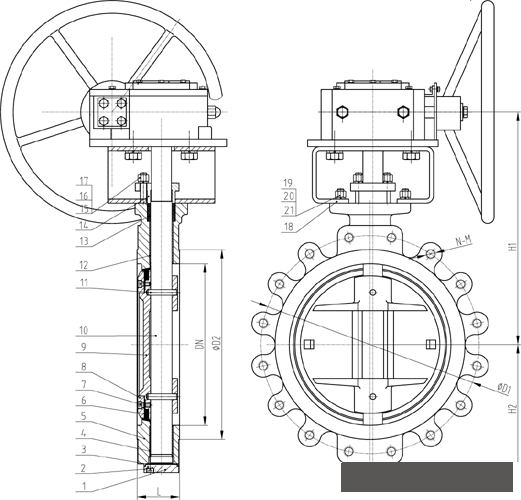
5.FAQ
1. What is manual wafer butterfly valve?
A: Wafer style is the more common of the two and is less expensive than the lug style. The wafer style butterfly valve is just about the standard. It ís so common that no one even bothers to use the word "wafer" when ordering a butterfly valve. It is taken for granted that if a butterfly valve is ordered, a wafer style will be received.
2. How about the Installation of the Wafer Style Butterfly Valve?
A: Butterfly valves are installed by inserting the valve between two flanges using bolts or studs and nuts to hold it all together. This type of installation, of course, makes it impossible to disconnect just one side of the piping system from the valve. That benefit is received using the lug style valve.
3. What is the working principle of manual wafer butterfly valve?
A: A butterfly valve is from a family of valves called quarter-turn valves. In operation, the valve is fully open or closed when the disc is rotated a quarter turn. The "butterfly" is a metal disc mounted on a rod. When the valve is closed, the disc is turned so that it completely blocks off the passageway. When the valve is fully open, the disc is rotated a quarter turn so that it allows an almost unrestricted passage of the fluid. The valve may also be opened incrementally to throttle flow.
- Q: Butterfly valve D41W-1, 41, W, 1, respectively, what does that mean?
- D--- stands for butterfly valves; 4--- refers to the form of flange connections; 1--- refers to the valve stem and disc in the center of the valve line, without eccentricity; w--- refers to the valve seat material and body material is the same, usually carbon steel. The final 1--- refers to the nominal pressure of 1 kg / cm2.
- Q: How do you explain A in butterfly valve D37A1?
- Represents a seal or lining material symbol.Said sealing ring or lining material with the Chinese phonetic alphabet: B Babbitts D nitrided steel, acid resistant stainless steel H, J L Aluminum Alloy, hard rubber, nylon NL, P leather, SA PTFE, SC PVC, SD bakelite, T copper, TC enamel, X rubber, Y hard alloy
- Q: What is the effect of nylon coating on butterfly valve plate? Thank you
- Mainly media will not be contaminated by rust on the body, you should say that the central soft sealing butterfly valve, the central valve is generally cast steel or cast iron material, so useNylon coatingLining up. There are soft seals, sealing performance is relatively high
- Q: What are single eccentric and double eccentric in butterfly valves? What's the difference, please explain in detail?
- Three eccentric butterfly valve: to high temperature, must use hard seal, but the leakage is large; to zero leakage, must use soft sealing, but not high temperature. In order to overcome the double eccentric butterfly valve this contradiction, and the butterfly valve for third times eccentric. The so-called third eccentric, that is, the shape of the sealing pair is not a positive cone, but rather oblique cone.Variable eccentric butterfly valve: variable eccentric butterfly valve is unique in that the valve stem axis installation disc is a three shaft type structure, the three stem shaft two concentric shafts, while the center section of the shaft center line and both ends of a center axis deviation distance, the installation disc in the middle section of the shaft. The eccentric structure makes the disc become double eccentric at full open position, and becomes eccentric when the disc rotates to the closed position. Due to the action of the eccentric shaft, near the close, the butterfly plate sealed to the seat by moving a distance within the cone, the butterfly plate and the valve seat sealing surface to achieve consistent and reliable sealing performance.
- Q: Butterfly valve switch direction respectively?
- If there is no arrow on the handwheel, the indicator on the turbine has been damaged, you can put your ear on the wall of the pipe, turn the handwheel, and through the sound of the pipe medium to determine the direction of the switch.
- Q: My bike has now 6200 miles on the odometer. The manual says that a valve adjustment should be performed every 6000 miles. But the bike runs fine. Can I just have the valve checked or should I have them adjusted even though the bike is fine? What will happen if I just keep riding it?
- In reality, lots of bikes go their entire lives without a valve adjustment. In my opinion that is a great way to ruin a bike though. They have a maintence schedule for a reason. If a valve isn't seating, it can hurt performance and the valve will not be able to transfer heat to the head. That can burn a valve and cause detonation. You have to check valves to adjust them, and the labor for just checking will be nearly the same or identical to doing the adjustments. I do all my own wrenching, so money isn't really an issue, but if I were you, I would just bite the bullet and take it in.
- Q: The difference between the directly buried gate and the flange valve and butterfly valve
- Buried gate also called buried gate valve, valve can be directly buried underground, built without manhole, reduce road excavation area; small well maintained road and beautiful room can reduce the difficulty of construction, reduce project cost. The directly buried soft sealing gate valve is divided into two types: telescopic type and fine fixing type, wherein, the telescopic type is divided into metal type and plastic type. In the process of construction, the telescopic type can be adjusted arbitrarily according to the distance between the buried depth of the valve and the ground, and the micro adjustment can be adjusted on the spot. The directly buried gate valve has the advantages of long-term use, no leakage, no maintenance, etc., and can effectively avoid other people switching the valve and stealing the manhole cover at will.Flange gate valve is connected to the flange gate valve, this connection is the most common way.
- Q: Hi guys, i asked a question before pertaining to the amount of cylinders and asking if it meant V4 or V6 or whatever.I actually meant to say VALVES, not cylinders. IS there a direct correlation between VALVES and Clyinders..Eg, My car, which is a 2001 Neon LE states right on the engine block quot;16 VALVEquot; in bright letters. I am sure this is a 4 cylinder engine. I haven't had a car that broadcasted the number of VALVES before. Another car I had broadcast that is was a 3.3 Liter V6 right on the engine.Is there a mathematical relationship between VALVES and cylinders, or would my car be braodcasting 16 VALVES, because a 4 cylinder doesn't typically HAVE 16 valves, or what is the story??Recently, I was looking at an altima, and it said 24 valves. Can you tell just by the number of valves if it is a 4 cylinder or 6 cylinder or whatever??Thanks.
- Well a lot of valves signify that more air/gas is getting to the engine so it suggests a more powerful engine. So your car has 4 valves per cylinder. Now that's pretty much a standard number so most expensive cars don't really even talk about that. They mostly just advertise the displacement. You can't really tell the type of engine via the number of valves because it does vary by manufacturer. For example there could be a 16 valve V8 also also(2 valves per cylinder). There are some ratios that dont work like a 16 valve V6 because you cannot have 2.6 valves.
- Q: What is the difference between the installation and function of a butterfly valve and butterfly valve?
- Therefore, the fully open position of the valve is determined by the position of the gate. Some gate valve, stem nut is located on the gate, the handwheel rotates to drive the stem to rotate, and make the gate lift, this kind of valve is called rotary bar gate valve, or call dark rod gate valve. The type of gate width, sealing surface configuration can be divided into wedge gate valve and parallel gate valve, wedge gate type valve can be divided into: single gate type, dual gate plate and the flexible gate type; parallel gate type valve can be divided into single and dual gate gate plate. According to the thread position of the valve stem, can be divided into two kinds of open rod gate valve and dark rod gate valve. Valve installation and maintenance should pay attention to the following: hand wheel, handle and transmission mechanism are not allowed for lifting, and is strictly prohibited. Double gate valve should be installed vertically, that is, the valve stem is in a vertical position, and the handwheel is at the top. The gate valve with bypass valve shall be opened before opening to balance the pressure difference between inlet and outlet and reduce the opening force. The gate valve with drive mechanism is installed according to the instruction of the product instruction. If the valve is constantly switched on, lubricate it at least once a month. The valve has the advantages of small fluid resistance, the sealing surface by the erosion of small and medium Chong brush. Opening and closing is more labor-saving. Medium flow direction is unrestricted, no disturbance, no pressure reduction. The utility model has the advantages of simple shape, short structural length, good manufacturing technique and wide application range. Valve faults between the sealing surface can lead to erosion and abrasion, maintenance more difficult. Larger size, open need a certain space, long opening and closing time. Complex structure.
- Q: Butterfly valve D71X-16 and D71X-16Q what is the difference?
- The two difference is that the body of the material is not the same, 16 behind with no sign, expressed as a default, is carbon steel (usually C), if you need to specify material, just behind with symbols, such as Q nodular cast iron, stainless steel P.
Send your message to us
Butterfly Valve Turbine Type DN150 BS Standard
- Loading Port:
- Tianjin
- Payment Terms:
- TT OR LC
- Min Order Qty:
- 50 pc
- Supply Capability:
- 5000 pc/month
OKorder Service Pledge
OKorder Financial Service
Similar products
Hot products
Hot Searches
Related keywords
